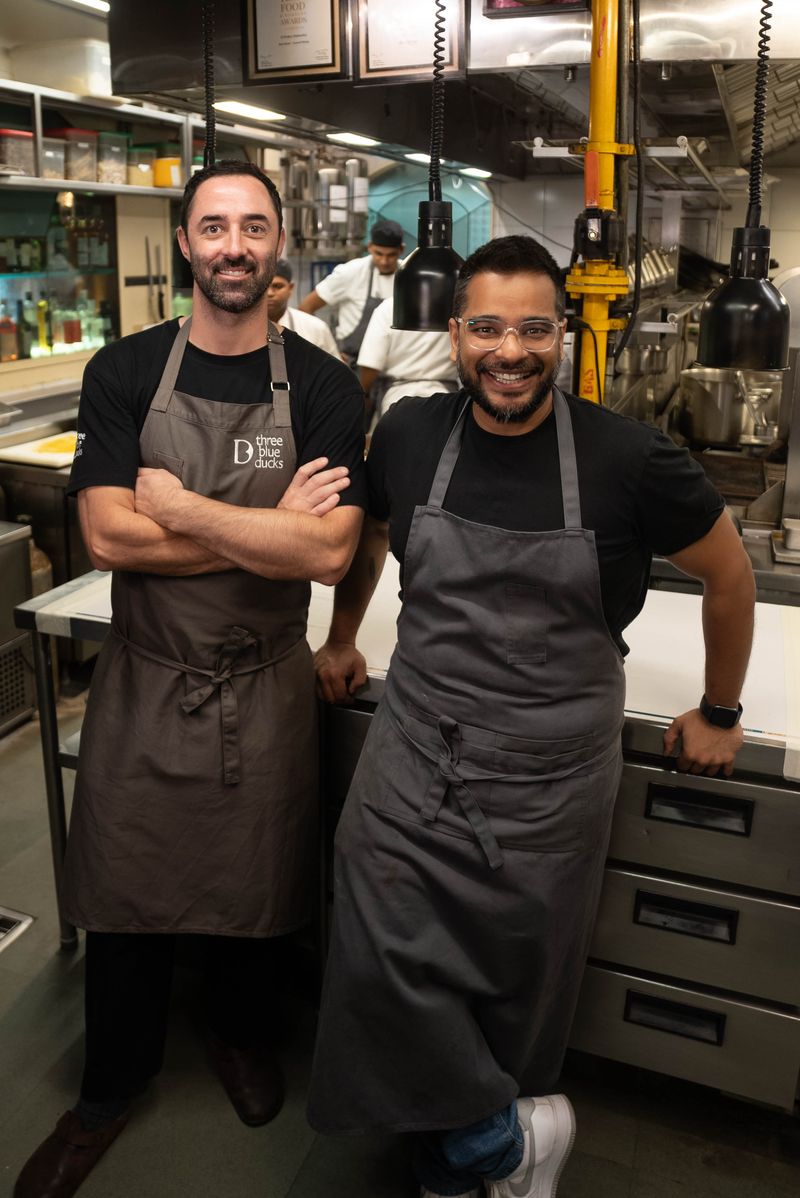If you watch MasterChef Australia, chances are you know who Andy Allen is. He was back in India, just four months after his December visit, courtesy a special collaborative dinner with chef Hussain Shahzad at O Pedro, Mumbai. Honestly, we hadn’t expected it to happen so soon, and neither had he. Chef Allen shares, “It's incredible that just four months later, we're working together, creating fantastic dishes in their wood oven. The collaboration seamlessly blends the laid-back cheerful charm of Australia with the sunny vibrant energy of Goa, bringing diners an unforgettable experience to savour.”
The tasting experience introduced patrons to Australia’s indigenous ingredients such as finger limes, incredible seafood and barbecues – Buffalo tataki, wood-roasted Spatchcock with fermented chilli and roasted corn, and Macadamia Tabbouleh to name a few. Chef Shahzad, recalling his first encounter with this caviar lime in Melbourne, calls it a ‘game-changer’. He describes it as a simple yet extraordinary addition that elevates dishes with its delightful pop, “This indigenous Australian ingredient is a culinary gem that hasn't made its way to India yet. It's a simple yet extraordinary addition that's got everyone talking. This tiny citrus gem, resembling caviar pearls, adds a delightful pop to dishes, elevating them to a whole new level.”

While seemingly different, both Goan and Australian cuisine share a fascinating connection. Shahzad explains how both reflect the influences of diverse populations, shaping their flavours and ingredients. Highlighting the parallels, he says, “Goan cuisine, with its blend of Portuguese and Indian flavours, resonates with the diverse culinary landscape of Australia. Whether it's a hearty curry or a fresh seafood dish, both cuisines tell stories of migration, adaptation, and the joy of sharing a meal with others.”
Edited excerpts from Andy Allen’s interview:
1. What’s your food philosophy?
It would be to keep food exciting and fun and not being afraid to push techniques and flavours to the absolute limit. A crucial aspect of this is staying open to exploring new foods, discovering different cuisines, and always keeping that learning switch turned on.
2. Any culinary anecdotes you would like to share from your childhood? Your comfort food or a dish you have grown up eating and memories attached to it?
I wouldn't attribute it to my childhood, but rather to a great piece of advice I got when I first appeared on MasterChef, which has stayed with me since. The advice was to take every opportunity as a learning opportunity. Even now, being here and working in someone else's kitchen, I've gained a wealth of knowledge. It's not just about food; it's about understanding how a kitchen operates and learning new skills. My learning switch is always on, regardless of my location, task, or company. I just love to learn.
3. We all know you can't handle spicy food, what street food did you try this time in Delhi and Mumbai? Any favourites?
I’ve had pani puri and samosa. I think I was alright with the spice. I like spice; it just makes me emotional! It makes me tear up and sweat but I genuinely relish it. People often underestimate my tolerance for spice, but that doesn't change my love for it.
4. Any Indian ingredient that you would like to take back with you? And why?
There are a few things I've tried here. The lemon pepper seasoning (although I can't recall its traditional name) was absolutely amazing. Kokum is another favourite of mine; it has a sourness that's quite distinctive, along with an interesting texture. Davidson Plum (an Australian native ingredient), on the other hand, is much more intense, which is exactly why I wanted to bring it to India. Its sour and punchy flavour seems like a perfect match for certain dishes. Similarly, I find kokum to have that same zing that complements various cuisines.
5. Can you share some insights into your favourite native ingredients or flavour combinations that you enjoy working with?
One of my favourite Aussie native ingredients is finger limes. They're like little bursts of citrus that add incredible flavour and dimension to most dishes. It’s like citrus caviar. Then there's lemon myrtle, which has this amazing lemony scent that I love using, especially in seafood dishes.
6. What can one expect from a meal at Three Blue Ducks?
We focus a lot on locally sourced seasonal ingredients that showcase the best of Australian produce. The menu at Three Blue Ducks is both adventurous and comforting — hearty and vibrant meals with bags of flavour. The common thread woven throughout our five venues is a commitment to ethical food and supporting small farmers and producers. It’s about working with what’s available and using quality ingredients that are as organic as can be.
7. According to you, what makes Australia a culinary paradise?
It’s our multicultural population. We're so lucky over there, to be made up of all parts of the globe and to be able to experience the best of the best when it comes to food from all around the world in our backyard. This multiculturalism also gives us the freedom to draw inspiration from a wide range of cultures and cuisines, whether it's through ingredients or cooking techniques, to create our own unique culinary identity. And then, like a cherry on top, we also have our indigenous ingredients, which are unlike anything else found in the world. We're incredibly fortunate in Australia, and it's a wonderful experience to be a part of its rich culinary tapestry.
Disclaimer: The views expressed in the article reflects the author(s) opinions and do not necessarily represent the views of the publisher and editor.



_1716187298187_thumb_300.jpeg)